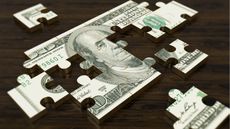How Much Cash Should Retirees Hold?
If you’re thinking about three months' worth of expenses, you might want to think again. Three years' worth might be more like it for many people.


Retirees tread a tricky line: Keep enough cash in their pockets to cover the unexpected but not so much that inflation nibbles away at their nest egg. However, in my firm’s experience, we find many retirees maintain only a fraction of the optimal level of cash.
Although many savers rely on the “three-to-six months' of expenses” rule of thumb, many fail to consider how their needs change in retirement. Research suggests most people require a significantly larger cash reserve during this stage of life, especially if they rely on their investment portfolio for a substantial portion of their income.
We understand why people can be averse to holding more cash, given the abysmally low yields on savings accounts and CDs. We also acknowledge that longtime habits are hard to break.

Sign up for Kiplinger’s Free E-Newsletters
Profit and prosper with the best of expert advice on investing, taxes, retirement, personal finance and more - straight to your e-mail.
Profit and prosper with the best of expert advice - straight to your e-mail.
Having said that, if you are in or approaching retirement, we strongly suggest taking another look at your cash levels. There are several benefits to maintaining a larger reserve – some of which aren’t obvious:
#1: Safety During Stock Market Downturns
Creating a reliable income stream is much harder than in past generations, when Treasury yields were higher and life spans were shorter. Prior generations were able to retire comfortably by investing in long-term government bonds and simply living off the interest.
Conditions are more difficult now. With the low rates on guaranteed investments (you’re lucky if you can get anything near 2.5% on one-year CDs these days), an investor must be willing to take on market risk in order to outpace inflation, or else his standard of living will erode. Rising life expectancies compound the challenge.
Outside of a catastrophic event (a health emergency, etc.), the greatest retirement risk is having to withdraw funds from a portfolio during severe market conditions, which happened to many people during the Great Recession. These withdrawals magnify the impact of the downturn, since more securities need to be sold at temporarily low prices in order to cover their expenses.
One way to mitigate this risk is to maintain enough cash to ride out a bear market, thereby allowing your portfolio to recover before making further withdrawals. How much? The necessary reserve will depend upon your specific asset mix. For example, a portfolio consisting entirely of intermediate-term government bonds will require less of a cushion than an all-stock portfolio. For a balanced portfolio of 60% stocks and 40% bonds, you might need to keep roughly three years’ worth of anticipated withdrawals in cash.
#2: Peace of Mind? Priceless
Some retirement worries are outside of your control, such as market or economic conditions. Where possible, however, any concerns that can be eliminated should be.
There is a tremendous amount of comfort in knowing your immediate portfolio distributions are safe. With ample reserves, it’s much easier to maintain a longer-term perspective when markets become choppy.
#3: Higher Returns, Greater Overall Wealth
This is the perhaps greatest surprise to most people, because it seems counterintuitive. However, a higher level of cash reserves can lead to greater overall returns, because it allows an investor to maintain more risk in the remaining portfolio. These higher expected returns might more than offset the idle cash, and potentially produce far greater wealth long-term.
Best Practices for Your Cash Reserves
For those withdrawing around 4% of their initial portfolio, research generally shows the optimal long-term portfolio mix to be roughly 60% to 70% stocks, with the rest in high-quality bonds. When combined with a reserve of three years' worth of anticipated withdrawals, this provides a powerful blend of liquidity and safety combined with long-term growth potential.
To mitigate the impact of low yields, we typically recommend maintaining only a portion of this cushion in money market funds or savings accounts. Remaining cash can be allocated into CDs, short-term high-grade bonds, or other slightly less liquid assets that can potentially outperform money market rates. Short-term U.S. Treasury ETFs are a good example, while those in a higher tax bracket may prefer low duration municipal bond funds that maintain a high credit quality.
One cautionary note: Don’t fall victim to the temptation to “reach for yield” in this sleeve of your portfolio. As investors learned in the Great Recession, the risk entailed with even a slight increase in yield can be significant. It’s not worth risking the sustainability of your portfolio in order to potentially earn a little bit more on your cash. This is where you play it safe.
Conclusion
Maintaining optimal cash levels is a key part of an integrated retirement plan. If you haven’t reviewed your cash allocations recently, the recent return of market volatility might be a compelling reason to take another look.
Get Kiplinger Today newsletter — free
Profit and prosper with the best of Kiplinger's advice on investing, taxes, retirement, personal finance and much more. Delivered daily. Enter your email in the box and click Sign Me Up.

Michael Yoder, CFP®, CRPS®, writes about issues affecting retirees and those transitioning into retirement. He is Principal at Yoder Wealth Management (www.yoderwm.com), a Registered Investment Advisor. 2033 N. Main St., Suite 1060, Walnut Creek, CA 94596. 925-691-5600.
-
 Stock Market Today: The Dow Leads an Up Day for Stocks
Stock Market Today: The Dow Leads an Up Day for StocksBoeing, American Express and Nike were the best Dow stocks to close out the week.
By Karee Venema Published
-
 Black Friday Deals: Are They Still Worth It in 2024?
Black Friday Deals: Are They Still Worth It in 2024?Is Black Friday still the best day for deals? We share top tips for smart holiday shopping.
By Jacob Wolinsky Published
-
 Six Missteps to Avoid as You Transition to Retirement
Six Missteps to Avoid as You Transition to RetirementDon't lose sight of your finances when you finally reach retirement. These six classic missteps can chip away at the nest egg you’ve worked so hard to build.
By Bill Leavitt Published
-
 Why Does One Claim Jack Up My Insurance After Years of No Claims?
Why Does One Claim Jack Up My Insurance After Years of No Claims?Even loyal customers can be hit with an insurance premium hike after a claim, despite going many years without any claims. There's a reason for that.
By Karl Susman, CPCU, LUTCF, CIC, CSFP, CFS, CPIA, AAI-M, PLCS Published
-
 To Future-Proof Retirement Security, We Need Better Strategies
To Future-Proof Retirement Security, We Need Better StrategiesWith retirees living longer and the inequalities that affect women and people of color, the retirement system needs some optimization. Here’s what would help.
By Romi Savova Published
-
 Here's Why We All Win When Charitable Dollars Go to Women
Here's Why We All Win When Charitable Dollars Go to WomenGiving to charities for women and girls not only has a lasting impact on their lives — it also benefits society as a whole. Here’s how to start investing.
By Elizabeth Droggitis Published
-
 For a More Secure Retirement, Build in Some 'Safe Money'
For a More Secure Retirement, Build in Some 'Safe Money'To solidify your retirement plan, write it down, reduce your market risk and allocate more safe money into your plan for income.
By Kevin Wade Published
-
 Five Steps to a Mindfully Fearless Career
Five Steps to a Mindfully Fearless CareerIf, like many women, you're struggling with imposter syndrome, try developing an athlete's winning mindset. It's as simple as facing one small fear every day.
By Lisa Cregan Published
-
 Six Ways to Optimize Your Charitable Giving Before Year-End
Six Ways to Optimize Your Charitable Giving Before Year-EndAs 2024 winds down, right now is the time to look at how you plan to handle your charitable giving. The sooner you start, the more tax-efficient you can be.
By Julia Chu Published
-
 How Preferred Stocks Can Boost Your Retirement Portfolio
How Preferred Stocks Can Boost Your Retirement PortfolioHigher yields, priority on dividend payments and the potential for capital appreciation are just three reasons to consider investing in preferred stocks.
By Michael Joseph, CFA Published